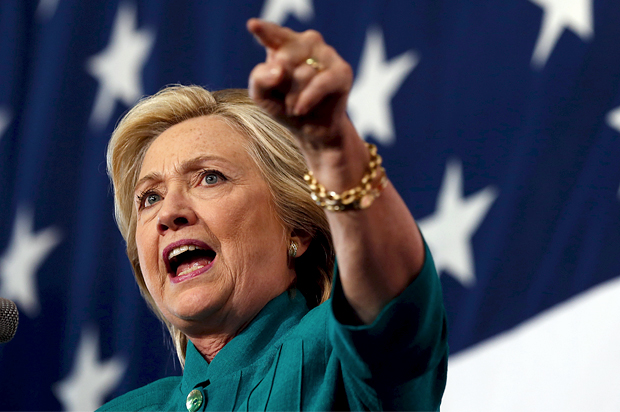If you’re one of the precious few Americans who does not already hold an opinion about Hillary Clinton already, there’s one thing she and her campaign want you to know: She’s a fighter, a tenaciously hard worker, and she never quits.
Or at least that’s the gist of a Monday report in the New York Times about the campaign-style speech the former first lady, senator and secretary of state delivered in New York City this weekend. According to the Times’ Amy Chozick and Patrick Healy, Clinton “made 14 references to herself as a fighter” during her “roughly 45-minute speech” — a speech that, incidentally, was framed around the “four fights” Clinton says she’ll wage if she’s elected president. Her campaign’s hope, the Times reports, is that all this talk of conflict will “persuade middle-class voters that she is on their side.”
More interesting, however, was what the Times called a “subtle message” embedded in the fighter messaging. Namely, that Clinton, unlike the current president, is not the kind of politician who hopes or expects to do her job while avoiding a fight. The Times then tries to use last week’s vote over President Obama’s trade agenda as a framing device. But I think that’s incoherent; Obama lost because he lacked allies, not because he didn’t want to quarrel. A better framework for understanding the contrast between the two politicians, I’d argue, is to look back to their legendary battle in the Democratic primary of 2008.
As the Times notes, Clinton’s decided she’s better off embracing Obama’s legacy than running from it, so it’s unlikely she’d ever publicly make her argument in these terms. But by trying to brand herself as a tough, scrappy and indefatigable fighter, Clinton is in some ways returning to the fundamental philosophical difference between herself and then-Senator Obama. And she’s saying that time and experience have shown that Obama was wrong. America doesn’t need a reconciler; it needs a president who can simply get things done — with or without a fight.
That assessment, I believe, is correct. And it’s a testament to Clinton’s intellect and political savvy, her being able to recognize that outcomes are what matter to voters, not process. Even if her analysis is sound, however, the “fighter” strategy still must confront one big question and must defeat one big myth. The question is whether the Obama years have taught Americans that their politics is broken because of structure, not individual politicians. And the myth is that there are “common-sense” solutions we could all agree upon, if only vulgar and venal politicians would get out of the way — or fall in line.
The big question is a potential stumbling block for Clinton because, if the answer is no, it means an outsider or newbie — like Sen. Marco Rubio — could win by promising voters he’s simply more congenial than the next guy. It could mean lines like the one Rubio used during his campaign announcement, the one about how we can’t “change the decisions we are making” without “changing the people who are making them,” could work. If the problem is the bums in Washington, and not Washington itself, then the solution is easy: get rid of the bums. Voters felt they did this in 2008, and it’s part of the reason why they blamed Obama when, in 2010, things were still rotten.
As ongoing and mainstream discussions of inequality and corruption suggest, though, U.S. politics is more attuned to structural forces today than it was when Obama was first elected. Which is why Clinton’s campaign is probably less threatened by this looming question than it is by the enduring myth. The appeal of a “Mr. Smith Goes to Washington” view of politics is still strong in America; there’s still an idea that “common sense” would solve the country’s problems if the politicians and the lobbyists would let it. That’s no less false than the narrative holding that the bums in Congress are to blame for the nation’s ills, but it may be harder for Clinton to crack.
The “Mr. Smith…” myth is dangerous because it so naturally leads one to believe that the problems in Washington can be attributed to a lack of leadership. Obama played into that narrative when he tried to sell himself as post-partisan and above ideology, and when the concrete realities of ideology and partisanship hit the brakes on his agenda, he was vulnerable to charges of being a poor leader. A fighter, however, is something different. By its very nature, the framing presumes that we don’t all agree about everything — otherwise there’d be no one to be fighting with. In this context, failures are easier to understand and even forgive; not even the best fighter always wins.
It may be counterintuitive to say this, since American political rhetoric is so fond of portraying conflict-averse politicians as the “grown-ups” in the room, but by embracing the “fighter” moniker, Clinton is showing an uncharacteristic willingness to trust that she can speak to the American people as if they were adults. Implicitly, she’s assuming that enough voters noticed during the Obama years that there are, in fact, such things as red and blue states; and that we are a nation of divisions, as we’ve always been. She’s hoping that voters now have a new understanding of their government, and that they’re willing now to pick a candidate who will fight the system instead of trying to rise above it.
And as someone who’s always hated it when fairy tales intrude upon politics, I hope she’s correct.

